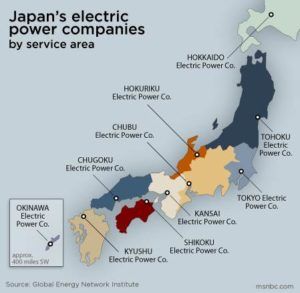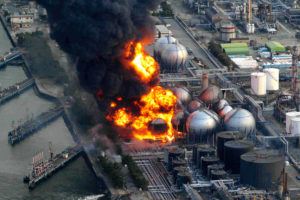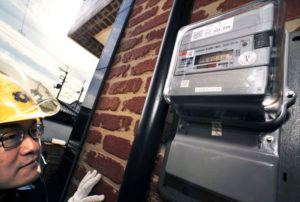The dilemma of Kansai Electric Power Company

What should a company do when an unforeseen tragedy changes its clean energy initiatives? Should we listen to the public view that the risk of another nuclear meltdown outweighs the concerns over climate change?
Kansai Electric Power Company’s clean energy initiatives
Japan is comprised of ten privatized power companies, each covering a specific region.[1] Kansai Electric Power Company (KEPCO) covers the Kansai region of Japan – supplying electricity to over 20 million people (approximately 16% of the population).[1] KEPCO has been the leading power company in Japan to aggressively pursue clean energy initiatives to combat climate change. KEPCO invests heavily in nuclear power and LNG power plants. As of 2011, KEPCO had 11 nuclear power plants and more than half of its electricity were generated from nuclear energy.[2]
Figure 1: Japan’s electric power companies
A Nuclear disaster and regulations against nuclear energy
A 9.0 magnitude earthquake struck Japan’s northeast coast on March 11, 2011.[1] What was not expected, however, was the tsunami that followed the earthquake. The tsunami destroyed the nuclear power plants in Fukushima, causing three nuclear meltdowns and the release of radiation. The Japanese government regulated all nuclear power plants in Japan to shut down their operations immediately.
Even though the power plants in Fukushima were owned by Tokyo Electric Power Company (TEPCO), all power companies including KEPCO were heavily criticized by the public for its use of nuclear power plants. KEPCO was forced to shut down all 11 of its nuclear power plants and injunctions were filed against the company from restarting them.[3] Since more than half of KEPCO’s electricity was generated from nuclear energy, the company had to adjust its operations in order to continue to provide electricity to the Kansai region.
Figure 2: Fukushima nuclear disaster
KEPCO’s dilemma and new clean energy activities
Since 2011, the Japanese government imposed regulations against nuclear energy. As a result, KEPCO has had to increase its fossil fuel consumption to meet the electricity demands of the people in the Kansai region.[1] The current energy policy landscape in Japan affects KEPCO in multiple ways. First, fossil fuel consumption will continue to rise to cover the capacity of nuclear energy and KEPCO will need to expand and diversify its fossil fuel procurement sources.[4] Second, with increase in GHG emissions, carbon tax costs will increase for the company. KEPCO will incur further losses and will be unable to invest in cost-efficient, clean energy. Furthermore, continuing to be forced to abandon clean energy initiatives may eventually repel revenues from customers who are eco-conscious.
KEPCO now faces the dilemma of pursuing clean energy or investing in fossil fuels. The public views nuclear energy (a form of clean energy) as disastrous and the possible risk of another nuclear disaster greatly outweighs the detrimental effects of climate change.[5] To tackle this dilemma, KEPCO has made the following efforts to bring back clean energy initiatives:
- Restarted nuclear power plants
- Implemented a new combined-cycle power plant
- Invested in changing a power plant into a LNG plant
An important work for KEPCO has been to educate the public about the benefits of nuclear power in order to gain support to restart its nuclear power plants.[5] Management continues to invest time and money to communicate to the public about the importance of nuclear power and that a nuclear disaster like Fukushima is extremely rare. Despite these efforts, KEPCO’s nuclear power plants continue to be in injunction and shut down.[5] With this constraint, the company has decided to conduct climate change conscious investments by implementing more efficient fossil fuels. First, KEPCO has implemented a new combined-cycle power plant in Himeji.[6] Combined-cycle power plant allows for a more efficient, low emission alternative to its regular oil and gas power plant.[7] Second, KEPCO also invested to change one of its power plants in Aioi from an oil and gas plant to a LNG plant.[8]
Will KEPCO climb back up the clean energy trail?
KEPCO’s trouble with its clean energy initiative happened because its operational portfolio was dominated by nuclear energy. Although KEPCO’s management hopes that the strong opposition against nuclear energy will subside, it will take time for the company to face the difficult task of regaining the public’s trust.
Meanwhile, KEPCO should utilize the feed-in-trade program (FIT) and invest in smart grid technology. Introduced in Japan in July 2012, FIT allows power companies to purchase renewable energy at fixed prices – a system created to facilitate and expand renewable energy.[9] Effectively using FIT will allow KEPCO to expand its clean energy initiatives in sources other than nuclear energy.[10]
Figure 3: Smart meter set in a home by KEPCO worker
Another possible step for the company is to educate customers about the efficient use of electricity by providing them with smart grid technology.[11] Hoping to make customers more aware and efficient with their electrical usage, smart grid technology records and communicates the electrical usage of homes to customers.[11] KEPCO has an advantage because it has a telecommunication company as its subsidiary and could integrate its resources. By effectively integrating systems instituted by the government with technology, KEPCO may be able to climb back up the clean energy trail.
Word Count: 800 words
Sources:
- Kansai Electric Power Company Annual Report 2012 [KEPCO]. 2012. [ONLINE] Available at: http://www.kepco.co.jp/english/corporate/list/annual/pdf/kanden_ar_e_2012.pdf. [Accessed 04 November 2016]
- Kansai Electric Power’s Thermal Power Plants [KEPCO]. 2016. Kansai Electric Power’s Thermal Power Plants [KEPCO]. [ONLINE] Available at: http://www.kepco.co.jp/english/corporate/energy/thermal_power/plant/index.html. [Accessed 04 November 2016].
- Fukushima Accident – World Nuclear Association . 2016. Fukushima Accident – World Nuclear Association . [ONLINE] Available at: http://www.world-nuclear.org/information-library/safety-and-security/safety-of-plants/fukushima-accident.aspx. [Accessed 04 November 2016].
- Current situation of fuel procurement [KEPCO]. 2016. Current situation of fuel procurement [KEPCO]. [ONLINE] Available at: http://www.kepco.co.jp/english/corporate/energy/thermal_power/fuel/status.html. [Accessed 04 November 2016].
- The Mainichi. 2016. Court questions credibility of safety standards as it orders suspension of 2 reactors – The Mainichi. [ONLINE] Available at: http://mainichi.jp/english/articles/20160310/p2a/00m/0na/015000c. [Accessed 04 November 2016].
- Outline of Thermal Power Generation [KEPCO]. 2016. Outline of Thermal Power Generation [KEPCO]. [ONLINE] Available at: http://www.kepco.co.jp/english/corporate/energy/thermal_power/shikumi/index.html. [Accessed 04 November 2016].
- Himeji No.2 . 2016. Himeji No.2 . [ONLINE] Available at: http://www.gasturbineworld.com/himeji-no.2.html. [Accessed 04 November 2016].
- INTERVIEW: Japan’s Kansai Electric to link 20% of LNG buys to gas prices by 2020 – Natural Gas | Platts News Article & Story . 2016. INTERVIEW: Japan’s Kansai Electric to link 20% of LNG buys to gas prices by 2020 – Natural Gas | Platts News Article & Story . [ONLINE] Available at: http://www.platts.com/latest-news/natural-gas/tokyo/interview-japans-kansai-electric-to-link-20-of-26805038. [Accessed 04 November 2016].
- The Japan Times. 2016. Reviewing the feed-in tariff system | The Japan Times. [ONLINE] Available at: http://www.japantimes.co.jp/opinion/2016/01/24/editorials/reviewing-feed-tariff-system/#.WBuPSvkrJhE. [Accessed 04 November 2016].
- Hironao Matsubara, Institute for Sustainable Energy Policies. Achievements of Japan’s Feed-In Tariff Scheme and Challenges for Power System Reform. [ONLINE] Available at: http://www.japanfs.org/en/news/archives/news_id035140.html. [Accessed 04 November 2016]
- 日本経済新聞 電子版. 2016. 通信会社が「電力会社」になる日 スマートグリッドが生む競争図:日本経済新聞. [ONLINE] Available at: http://www.nikkei.com/article/DGXZZO38775360T10C12A2000000/. [Accessed 04 November 2016].






Nuclear energy is a fascinating aspect of the conversation on climate change. While it is a very clean, sustainable source of energy, it also has catastrophic, though rare, consequences when it fails. As a result, it is understandably a highly controversial solution to carbon emissions from traditional power generation. I would be curious to see if KEPCO’s move to a combined-cycle and a liquid natural gas power plant have been able to overcome the deficit from the 11 nuclear reactors removed from the power grid, or if KEPCO has had to rely on increased use of traditional fossil fuel plants, increasing its carbon emissions. Nuclear power seems to be a high risk, high reward proposition. I wonder at what point climate change will become severe enough that the trade-off makes sense to most people.